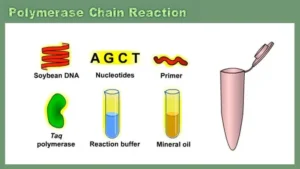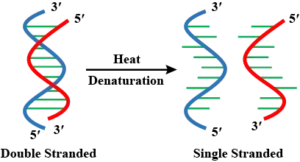
youtube.com
Polymerase Chain Reaction (PCR)
Brief Introduction
Polymerase Chain Reaction (PCR) technology has revolutionised the practice of science. It is the epic of the current explosion of technology in molecular biology. PCR is an advanced technique and it is not only used in the research labs but also use in clinical diagnosis, e.g., diagnosis of disease, predicting of disease, and identifying infectious agents. PCR has revolutionized molecular medicines and molecular biology. Major research areas such as gene regulation, biomarker discovery and cancer research are challenging today’s PCR technologies with more demanding requirements.
PCR is a molecular technique to make multiple copies or exponential amplification of the DNA from a specific region of DNA. Researchers can use PCR for any type of DNA sample in which they are interested. PCR is the initial stage of gene sequencing and it is also useful in the forensic lab for DNA matches at crime scenes.
Discovery:
Polymerase Chain Reaction was invented by Karry Mullis and his coworkers in 1985. He was awarded the Nobel Prize in Chemistry for his pioneering work in 1993.
Mullis wrote in Scientific American: Begining with a single molecule of the genetic material DNA, the PCR can generate 100 billion similar molecules in an afternoon. the reaction is easy to execute.
Use Of PCR:
PCR can be used in different fields:
Medicine: PCR is used to detect infectious organisms, discovering variations and mutations in genes.
Genome Project: It is used in DNA sequencing.
The Law: PCR is also used in fingerprinting.
Evolutionary: It is also used in the evolution history for taxonomic and classification of organisms.
Zoology: PCR can be also used in Zoology for the behaviour of animals.
Ecology: PCR is also useful in the study of seed dispersal reducing illegal trade in endangered species, and monitoring and release of GMOs (Genetic Modified Organism.
How Does PCR Work
The PCR is an in-vitro technique and is based on enzymatic DNA replication. The machine used in this technique is simply called the PCR machine or Thermocycler.
Component Of PCR:

orbitbiotech.com
DNA Template: DNA from the sample.
DNA Polymerase Enzyme:
For DNA replication PCR (thermocycler) require a DNA polymerase enzyme i.e Taq polymerase to generate a new strand of DNA. Taq polymerase is a thermostable enzyme, it does not denature at very high temperatures. It is isolated from heat-tolerant bacteria Thermus aquaticus. Taq polymerase is active at around 70° C and it is ideal for PCR. In the PCR process, high temperature is used repeatedly to denature i.e separate the DNA strands. Mg+2 ions are the essential cofactors of the Taq polymerase enzyme.
PCR Primer:
This is an oligonucleotide primer. Primers are short pieces of single-stranded DNA around 20 nucleotides in length. It is necessary to initiate DNA synthesis. In PCR reaction two types of Primer- Reverse primer and Forward primer are used. Taq polymerase can only make a new strand of DNA when primer, a short sequence of nucleotide is added that provides a starting point of DNA. PCR Primer is designed in such a way that it can flank the target region. During the annealing phase, i.e cooling phase of PCR primers bind to the target sequence and initiate the copying of the target region by complementary base pairing. When the primers are bound to the template it is extended by the DNA polymerase enzyme.
Buffer:
PCR buffer allows optimum amplification by DNA polymerase and DNA primer hybridization as well. Buffer provides a suitable chemical environment for the activity of DNA polymerase. The pH of the buffer is usually between 8.0-9.5 and it is stabilized by Tris-HCL oftentimes. Two ions present in the buffer Mg+2 and K+ provide optimum conditions for DNA denaturation and renaturation. PCR buffer can make in the laboratory and can be purchased by commercial supply. These cofactors promote primer annealing.
Deoxyribonucleotide Triphosphate: Deoxyribonucleotide Triphosphate is the nucleoside triphosphate containing deoxyribose. Deoxyribonucleotide Triphosphate (dNTP) provides energy for polymerization. They are building blocks for DNA synthesis. They lose two of the phosphate group when incorporated into DNA.
Principles Of PCR:
The principles of PCR are the same whatever the DNA sample it is. Above mentioned component DNA template, Taq polymerase, Primers, Buffer, and dNTP are key ingredients for PCR reaction. These ingredients are assembled in a tube for PCR setup. PCR involves a heating and cooling cycle called thermal cycling which is carried out by a thermal cycler or PCR machine.
Steps:
Denaturation: Denaturation occurs when a double-stranded is separated into a single strand at a high temperature of 94º C-96º C for about 0.5-2.0 minutes. This breaks the hydrogen bond between two strands of DNA. This single strand now acts as template DNA.

toppr.com Denaturation of DNA converted into ss DNA from double ds DNA
Annealing: In the annealing step reaction will cool at 55° C-65° C for around 20-40 seconds so that primer could bind to the single-stranded target DNA.

goldbio.com
Primer binds with ss DNA in the annealing process
Extending/Elongation: In this step, the temperature will be raised to 72 C and the thermostable Taq polymerase enzyme will extend the primer and will synthesize a new strand. This enzyme elongates the DNA in a 5′ to 3′ direction.

https://researchguides.library.vanderbilt.edu
Extension of DNA strand with the help of DNA polymerase Enzyme
These three steps or cycles repeat 20-40 times in a PCR reaction and this entire cycle takes approx 2 hours to complete. It doubles the number of copies each time. In the whole reaction, target DNA forms a million copies from one copy. That’s because it’s not an original copy of the DNA each time. A new DNA strand which is made in one round can serve as a template in the second round of DNA synthesis. The number of DNA can double in each cycle because there are many copies of primer and the Taq polymerase enzyme takes part in each cycle of the reaction.

wikipedia.com
Three steps of PCR make multiples copies of DNA
Conclusion:
The PCR reaction begins to generate the target sequence exponentially. It is only during the exponential phase of the PCR reaction that it is possible to extrapolate to determine the starting quantity of the target sequence contained in the sample. Due to the polymerase reaction inhibitors present in the sample, the limiting of the reagent, the accumulation of pyrophosphate molecules, and the self-annealing of the accumulating product, the PCR reaction amplifies the target sequence at an exponential rate and a “plateau effect generates”.
References: www.yourgenome.org
Disclaimer: All the content of this article is for information purposes only.

 Ribonucleic Acid (RNA): Structure, Types & Properties
Ribonucleic Acid (RNA): Structure, Types & Properties Gel Electrophoresis: Types and Properties
Gel Electrophoresis: Types and Properties DNA: Structure, Properties, Types
DNA: Structure, Properties, Types



[…] Real-Time Polymerase Chain Reaction is based on a conventional polymerase chain reaction laboratory technique that used in molecular biology for real-time monitoring of the amplification […]